Summer 2019 BUOL638: Strategic Analysis of Starbucks Corporation
VerifiedAdded on 2022/10/01
|7
|2309
|34
Case Study
AI Summary
This case study provides a comprehensive strategic analysis of Starbucks Corporation, focusing on its competitive environment, strategic planning processes, and ethical considerations. The analysis utilizes various strategic tools, including the Competitive Profile Matrix (CPM), Boston Consulting Group (BCG) Matrix, and Quantitative Strategic Planning Matrix (QSPM), to evaluate Starbucks' strengths, weaknesses, opportunities, and threats. The study examines Starbucks' marketing strategies, product portfolio, and market positioning, offering insights into its strategic decision-making. Furthermore, it addresses business ethics within a global context, specifically concerning issues of discrimination and environmental sustainability. The study concludes with recommendations for Starbucks to enhance its market position and address ethical concerns, emphasizing the importance of low-priced products in emerging economies and market development strategies, and highlights the significance of sustainability goals. This analysis is a valuable resource for students studying strategic management and business ethics, and is available on Desklib.
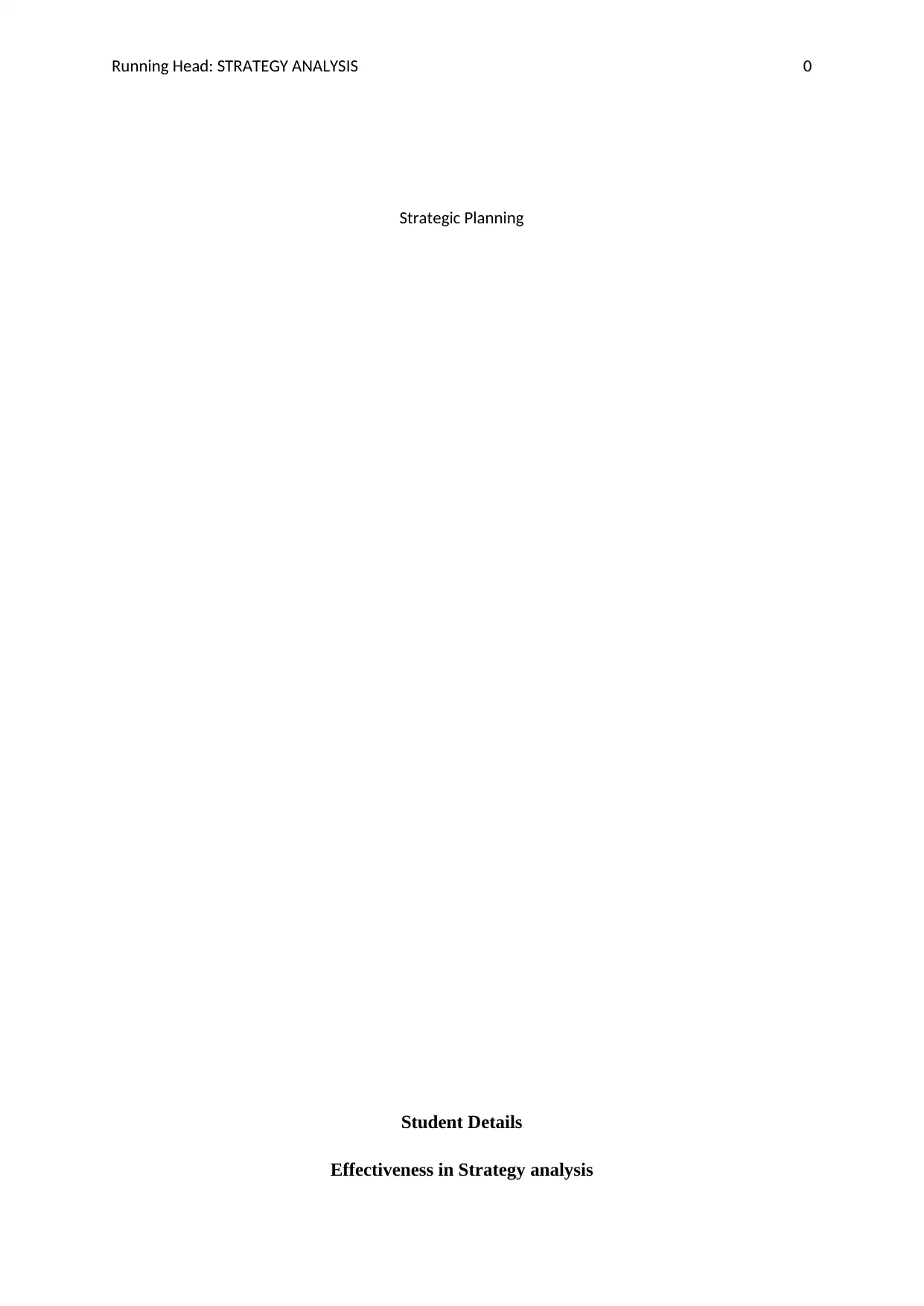
Running Head: STRATEGY ANALYSIS 0
Strategic Planning
Student Details
Effectiveness in Strategy analysis
Strategic Planning
Student Details
Effectiveness in Strategy analysis
Paraphrase This Document
Need a fresh take? Get an instant paraphrase of this document with our AI Paraphraser
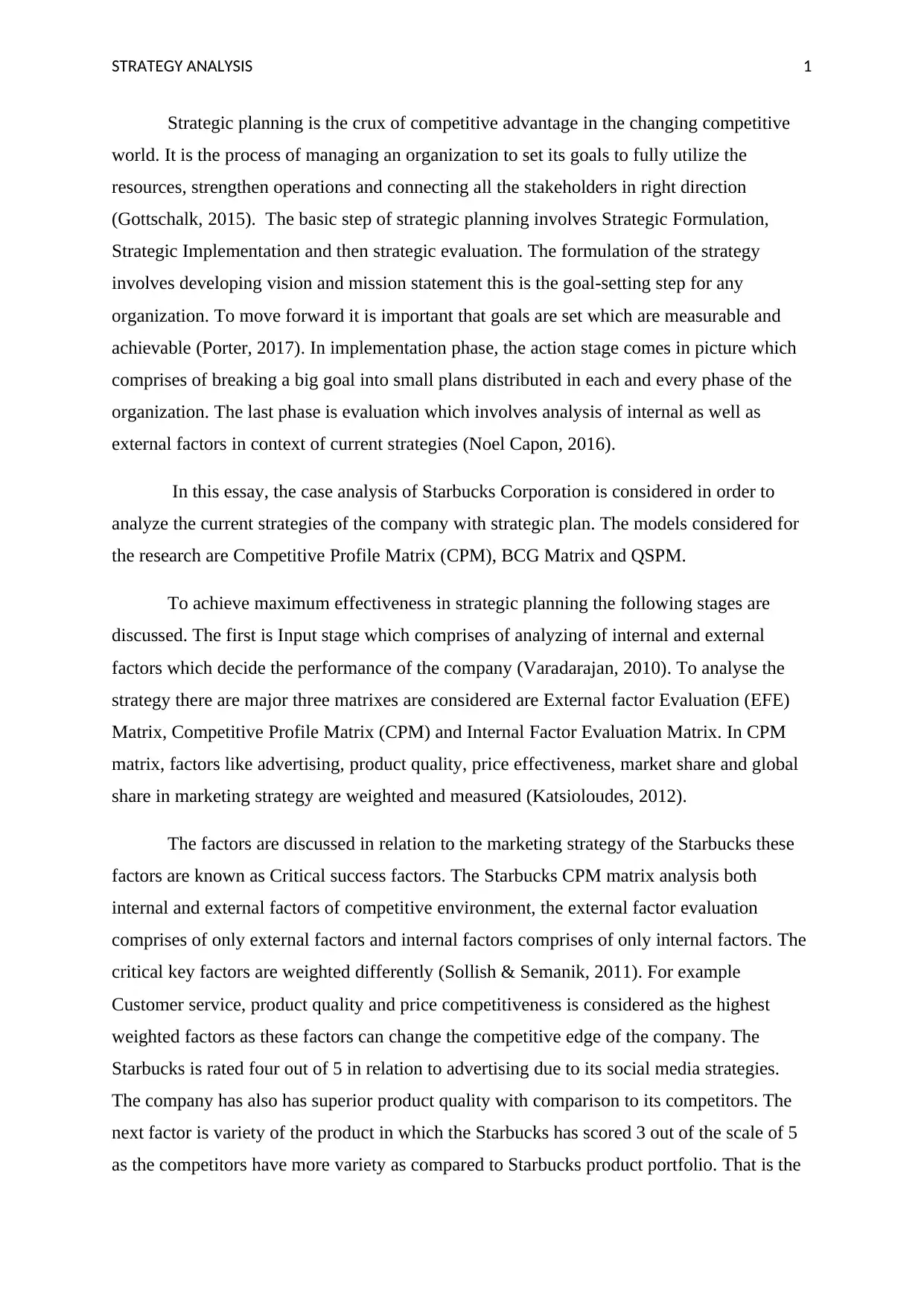
STRATEGY ANALYSIS 1
Strategic planning is the crux of competitive advantage in the changing competitive
world. It is the process of managing an organization to set its goals to fully utilize the
resources, strengthen operations and connecting all the stakeholders in right direction
(Gottschalk, 2015). The basic step of strategic planning involves Strategic Formulation,
Strategic Implementation and then strategic evaluation. The formulation of the strategy
involves developing vision and mission statement this is the goal-setting step for any
organization. To move forward it is important that goals are set which are measurable and
achievable (Porter, 2017). In implementation phase, the action stage comes in picture which
comprises of breaking a big goal into small plans distributed in each and every phase of the
organization. The last phase is evaluation which involves analysis of internal as well as
external factors in context of current strategies (Noel Capon, 2016).
In this essay, the case analysis of Starbucks Corporation is considered in order to
analyze the current strategies of the company with strategic plan. The models considered for
the research are Competitive Profile Matrix (CPM), BCG Matrix and QSPM.
To achieve maximum effectiveness in strategic planning the following stages are
discussed. The first is Input stage which comprises of analyzing of internal and external
factors which decide the performance of the company (Varadarajan, 2010). To analyse the
strategy there are major three matrixes are considered are External factor Evaluation (EFE)
Matrix, Competitive Profile Matrix (CPM) and Internal Factor Evaluation Matrix. In CPM
matrix, factors like advertising, product quality, price effectiveness, market share and global
share in marketing strategy are weighted and measured (Katsioloudes, 2012).
The factors are discussed in relation to the marketing strategy of the Starbucks these
factors are known as Critical success factors. The Starbucks CPM matrix analysis both
internal and external factors of competitive environment, the external factor evaluation
comprises of only external factors and internal factors comprises of only internal factors. The
critical key factors are weighted differently (Sollish & Semanik, 2011). For example
Customer service, product quality and price competitiveness is considered as the highest
weighted factors as these factors can change the competitive edge of the company. The
Starbucks is rated four out of 5 in relation to advertising due to its social media strategies.
The company has also has superior product quality with comparison to its competitors. The
next factor is variety of the product in which the Starbucks has scored 3 out of the scale of 5
as the competitors have more variety as compared to Starbucks product portfolio. That is the
Strategic planning is the crux of competitive advantage in the changing competitive
world. It is the process of managing an organization to set its goals to fully utilize the
resources, strengthen operations and connecting all the stakeholders in right direction
(Gottschalk, 2015). The basic step of strategic planning involves Strategic Formulation,
Strategic Implementation and then strategic evaluation. The formulation of the strategy
involves developing vision and mission statement this is the goal-setting step for any
organization. To move forward it is important that goals are set which are measurable and
achievable (Porter, 2017). In implementation phase, the action stage comes in picture which
comprises of breaking a big goal into small plans distributed in each and every phase of the
organization. The last phase is evaluation which involves analysis of internal as well as
external factors in context of current strategies (Noel Capon, 2016).
In this essay, the case analysis of Starbucks Corporation is considered in order to
analyze the current strategies of the company with strategic plan. The models considered for
the research are Competitive Profile Matrix (CPM), BCG Matrix and QSPM.
To achieve maximum effectiveness in strategic planning the following stages are
discussed. The first is Input stage which comprises of analyzing of internal and external
factors which decide the performance of the company (Varadarajan, 2010). To analyse the
strategy there are major three matrixes are considered are External factor Evaluation (EFE)
Matrix, Competitive Profile Matrix (CPM) and Internal Factor Evaluation Matrix. In CPM
matrix, factors like advertising, product quality, price effectiveness, market share and global
share in marketing strategy are weighted and measured (Katsioloudes, 2012).
The factors are discussed in relation to the marketing strategy of the Starbucks these
factors are known as Critical success factors. The Starbucks CPM matrix analysis both
internal and external factors of competitive environment, the external factor evaluation
comprises of only external factors and internal factors comprises of only internal factors. The
critical key factors are weighted differently (Sollish & Semanik, 2011). For example
Customer service, product quality and price competitiveness is considered as the highest
weighted factors as these factors can change the competitive edge of the company. The
Starbucks is rated four out of 5 in relation to advertising due to its social media strategies.
The company has also has superior product quality with comparison to its competitors. The
next factor is variety of the product in which the Starbucks has scored 3 out of the scale of 5
as the competitors have more variety as compared to Starbucks product portfolio. That is the
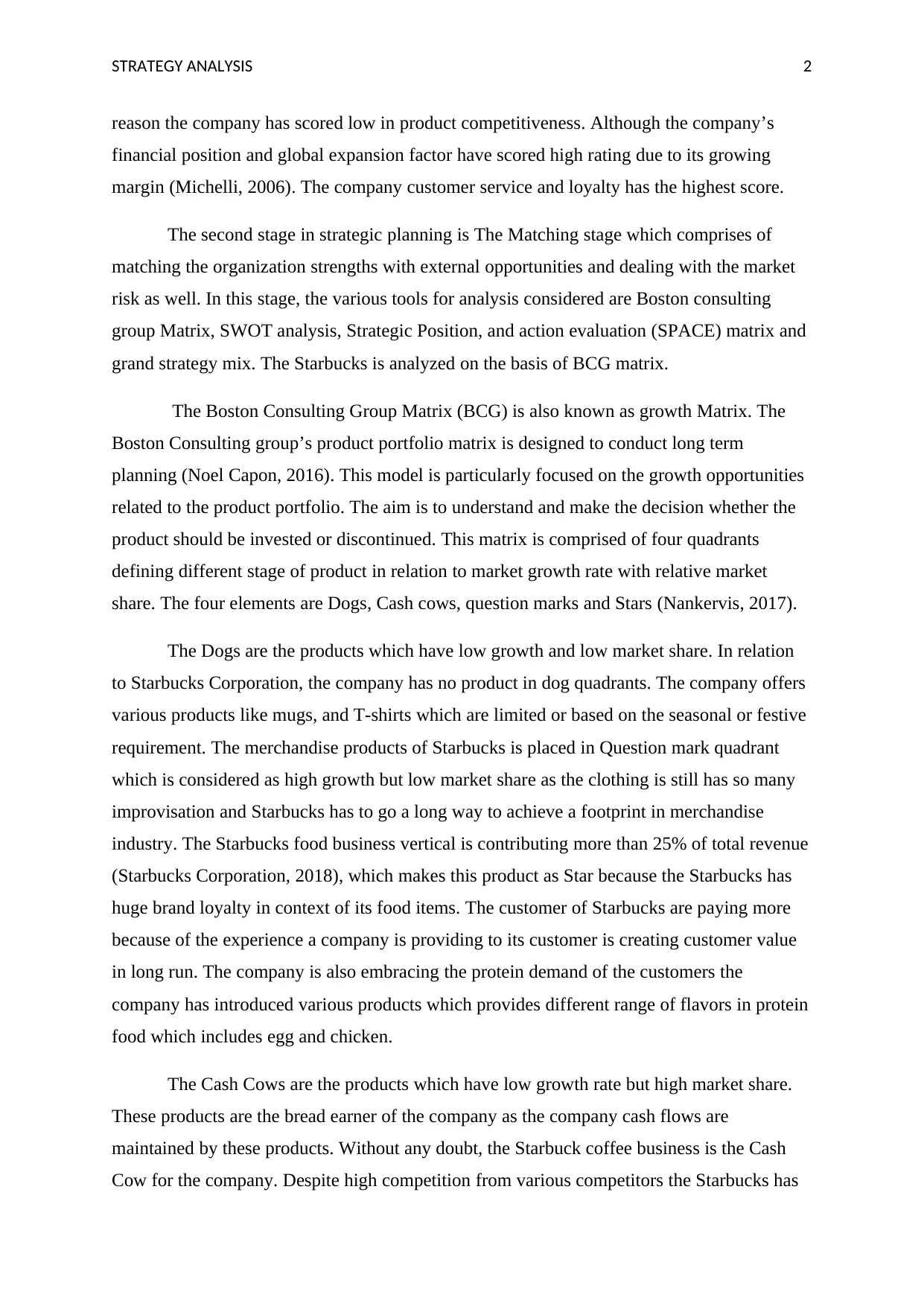
STRATEGY ANALYSIS 2
reason the company has scored low in product competitiveness. Although the company’s
financial position and global expansion factor have scored high rating due to its growing
margin (Michelli, 2006). The company customer service and loyalty has the highest score.
The second stage in strategic planning is The Matching stage which comprises of
matching the organization strengths with external opportunities and dealing with the market
risk as well. In this stage, the various tools for analysis considered are Boston consulting
group Matrix, SWOT analysis, Strategic Position, and action evaluation (SPACE) matrix and
grand strategy mix. The Starbucks is analyzed on the basis of BCG matrix.
The Boston Consulting Group Matrix (BCG) is also known as growth Matrix. The
Boston Consulting group’s product portfolio matrix is designed to conduct long term
planning (Noel Capon, 2016). This model is particularly focused on the growth opportunities
related to the product portfolio. The aim is to understand and make the decision whether the
product should be invested or discontinued. This matrix is comprised of four quadrants
defining different stage of product in relation to market growth rate with relative market
share. The four elements are Dogs, Cash cows, question marks and Stars (Nankervis, 2017).
The Dogs are the products which have low growth and low market share. In relation
to Starbucks Corporation, the company has no product in dog quadrants. The company offers
various products like mugs, and T-shirts which are limited or based on the seasonal or festive
requirement. The merchandise products of Starbucks is placed in Question mark quadrant
which is considered as high growth but low market share as the clothing is still has so many
improvisation and Starbucks has to go a long way to achieve a footprint in merchandise
industry. The Starbucks food business vertical is contributing more than 25% of total revenue
(Starbucks Corporation, 2018), which makes this product as Star because the Starbucks has
huge brand loyalty in context of its food items. The customer of Starbucks are paying more
because of the experience a company is providing to its customer is creating customer value
in long run. The company is also embracing the protein demand of the customers the
company has introduced various products which provides different range of flavors in protein
food which includes egg and chicken.
The Cash Cows are the products which have low growth rate but high market share.
These products are the bread earner of the company as the company cash flows are
maintained by these products. Without any doubt, the Starbuck coffee business is the Cash
Cow for the company. Despite high competition from various competitors the Starbucks has
reason the company has scored low in product competitiveness. Although the company’s
financial position and global expansion factor have scored high rating due to its growing
margin (Michelli, 2006). The company customer service and loyalty has the highest score.
The second stage in strategic planning is The Matching stage which comprises of
matching the organization strengths with external opportunities and dealing with the market
risk as well. In this stage, the various tools for analysis considered are Boston consulting
group Matrix, SWOT analysis, Strategic Position, and action evaluation (SPACE) matrix and
grand strategy mix. The Starbucks is analyzed on the basis of BCG matrix.
The Boston Consulting Group Matrix (BCG) is also known as growth Matrix. The
Boston Consulting group’s product portfolio matrix is designed to conduct long term
planning (Noel Capon, 2016). This model is particularly focused on the growth opportunities
related to the product portfolio. The aim is to understand and make the decision whether the
product should be invested or discontinued. This matrix is comprised of four quadrants
defining different stage of product in relation to market growth rate with relative market
share. The four elements are Dogs, Cash cows, question marks and Stars (Nankervis, 2017).
The Dogs are the products which have low growth and low market share. In relation
to Starbucks Corporation, the company has no product in dog quadrants. The company offers
various products like mugs, and T-shirts which are limited or based on the seasonal or festive
requirement. The merchandise products of Starbucks is placed in Question mark quadrant
which is considered as high growth but low market share as the clothing is still has so many
improvisation and Starbucks has to go a long way to achieve a footprint in merchandise
industry. The Starbucks food business vertical is contributing more than 25% of total revenue
(Starbucks Corporation, 2018), which makes this product as Star because the Starbucks has
huge brand loyalty in context of its food items. The customer of Starbucks are paying more
because of the experience a company is providing to its customer is creating customer value
in long run. The company is also embracing the protein demand of the customers the
company has introduced various products which provides different range of flavors in protein
food which includes egg and chicken.
The Cash Cows are the products which have low growth rate but high market share.
These products are the bread earner of the company as the company cash flows are
maintained by these products. Without any doubt, the Starbuck coffee business is the Cash
Cow for the company. Despite high competition from various competitors the Starbucks has
⊘ This is a preview!⊘
Do you want full access?
Subscribe today to unlock all pages.

Trusted by 1+ million students worldwide
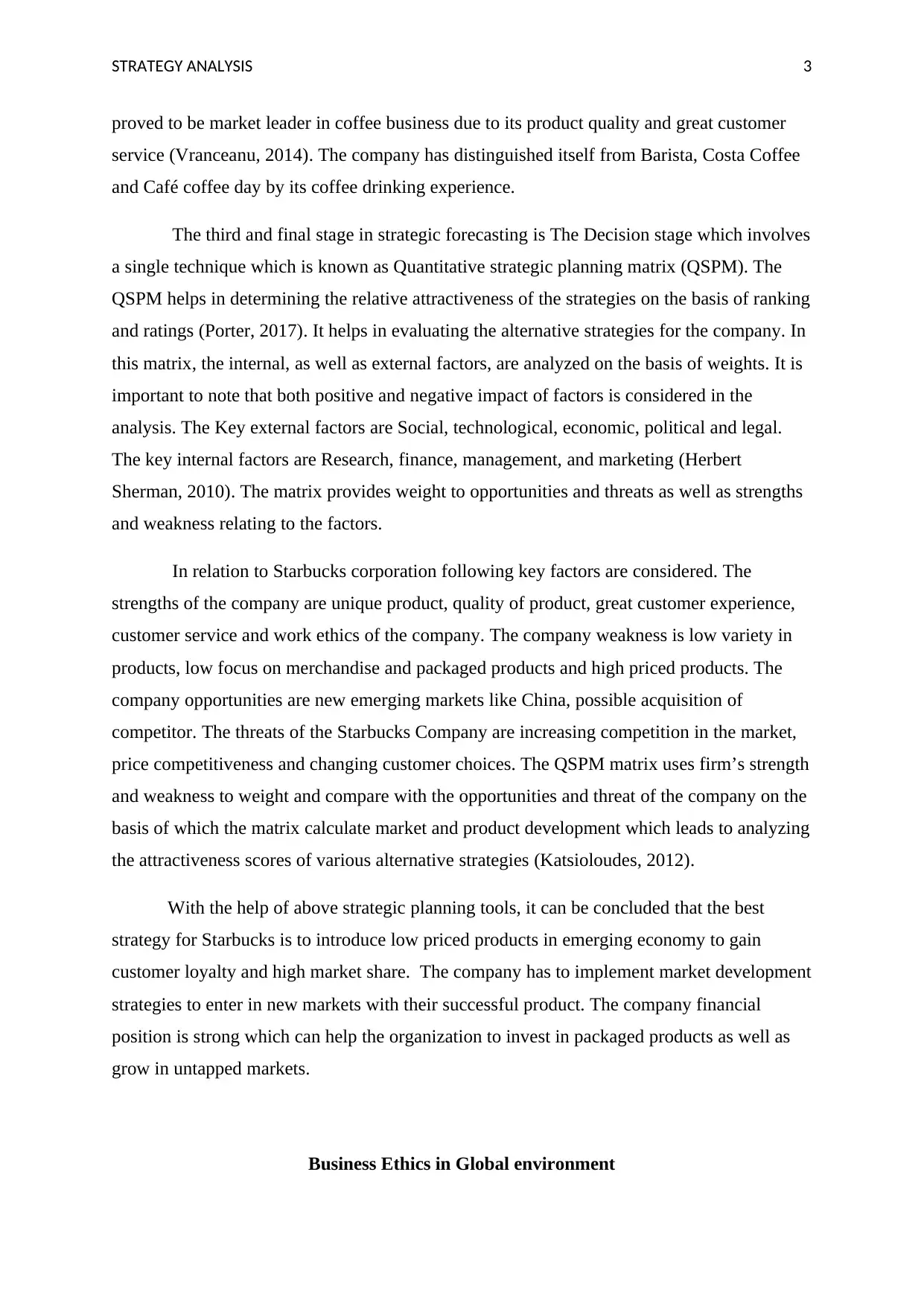
STRATEGY ANALYSIS 3
proved to be market leader in coffee business due to its product quality and great customer
service (Vranceanu, 2014). The company has distinguished itself from Barista, Costa Coffee
and Café coffee day by its coffee drinking experience.
The third and final stage in strategic forecasting is The Decision stage which involves
a single technique which is known as Quantitative strategic planning matrix (QSPM). The
QSPM helps in determining the relative attractiveness of the strategies on the basis of ranking
and ratings (Porter, 2017). It helps in evaluating the alternative strategies for the company. In
this matrix, the internal, as well as external factors, are analyzed on the basis of weights. It is
important to note that both positive and negative impact of factors is considered in the
analysis. The Key external factors are Social, technological, economic, political and legal.
The key internal factors are Research, finance, management, and marketing (Herbert
Sherman, 2010). The matrix provides weight to opportunities and threats as well as strengths
and weakness relating to the factors.
In relation to Starbucks corporation following key factors are considered. The
strengths of the company are unique product, quality of product, great customer experience,
customer service and work ethics of the company. The company weakness is low variety in
products, low focus on merchandise and packaged products and high priced products. The
company opportunities are new emerging markets like China, possible acquisition of
competitor. The threats of the Starbucks Company are increasing competition in the market,
price competitiveness and changing customer choices. The QSPM matrix uses firm’s strength
and weakness to weight and compare with the opportunities and threat of the company on the
basis of which the matrix calculate market and product development which leads to analyzing
the attractiveness scores of various alternative strategies (Katsioloudes, 2012).
With the help of above strategic planning tools, it can be concluded that the best
strategy for Starbucks is to introduce low priced products in emerging economy to gain
customer loyalty and high market share. The company has to implement market development
strategies to enter in new markets with their successful product. The company financial
position is strong which can help the organization to invest in packaged products as well as
grow in untapped markets.
Business Ethics in Global environment
proved to be market leader in coffee business due to its product quality and great customer
service (Vranceanu, 2014). The company has distinguished itself from Barista, Costa Coffee
and Café coffee day by its coffee drinking experience.
The third and final stage in strategic forecasting is The Decision stage which involves
a single technique which is known as Quantitative strategic planning matrix (QSPM). The
QSPM helps in determining the relative attractiveness of the strategies on the basis of ranking
and ratings (Porter, 2017). It helps in evaluating the alternative strategies for the company. In
this matrix, the internal, as well as external factors, are analyzed on the basis of weights. It is
important to note that both positive and negative impact of factors is considered in the
analysis. The Key external factors are Social, technological, economic, political and legal.
The key internal factors are Research, finance, management, and marketing (Herbert
Sherman, 2010). The matrix provides weight to opportunities and threats as well as strengths
and weakness relating to the factors.
In relation to Starbucks corporation following key factors are considered. The
strengths of the company are unique product, quality of product, great customer experience,
customer service and work ethics of the company. The company weakness is low variety in
products, low focus on merchandise and packaged products and high priced products. The
company opportunities are new emerging markets like China, possible acquisition of
competitor. The threats of the Starbucks Company are increasing competition in the market,
price competitiveness and changing customer choices. The QSPM matrix uses firm’s strength
and weakness to weight and compare with the opportunities and threat of the company on the
basis of which the matrix calculate market and product development which leads to analyzing
the attractiveness scores of various alternative strategies (Katsioloudes, 2012).
With the help of above strategic planning tools, it can be concluded that the best
strategy for Starbucks is to introduce low priced products in emerging economy to gain
customer loyalty and high market share. The company has to implement market development
strategies to enter in new markets with their successful product. The company financial
position is strong which can help the organization to invest in packaged products as well as
grow in untapped markets.
Business Ethics in Global environment
Paraphrase This Document
Need a fresh take? Get an instant paraphrase of this document with our AI Paraphraser
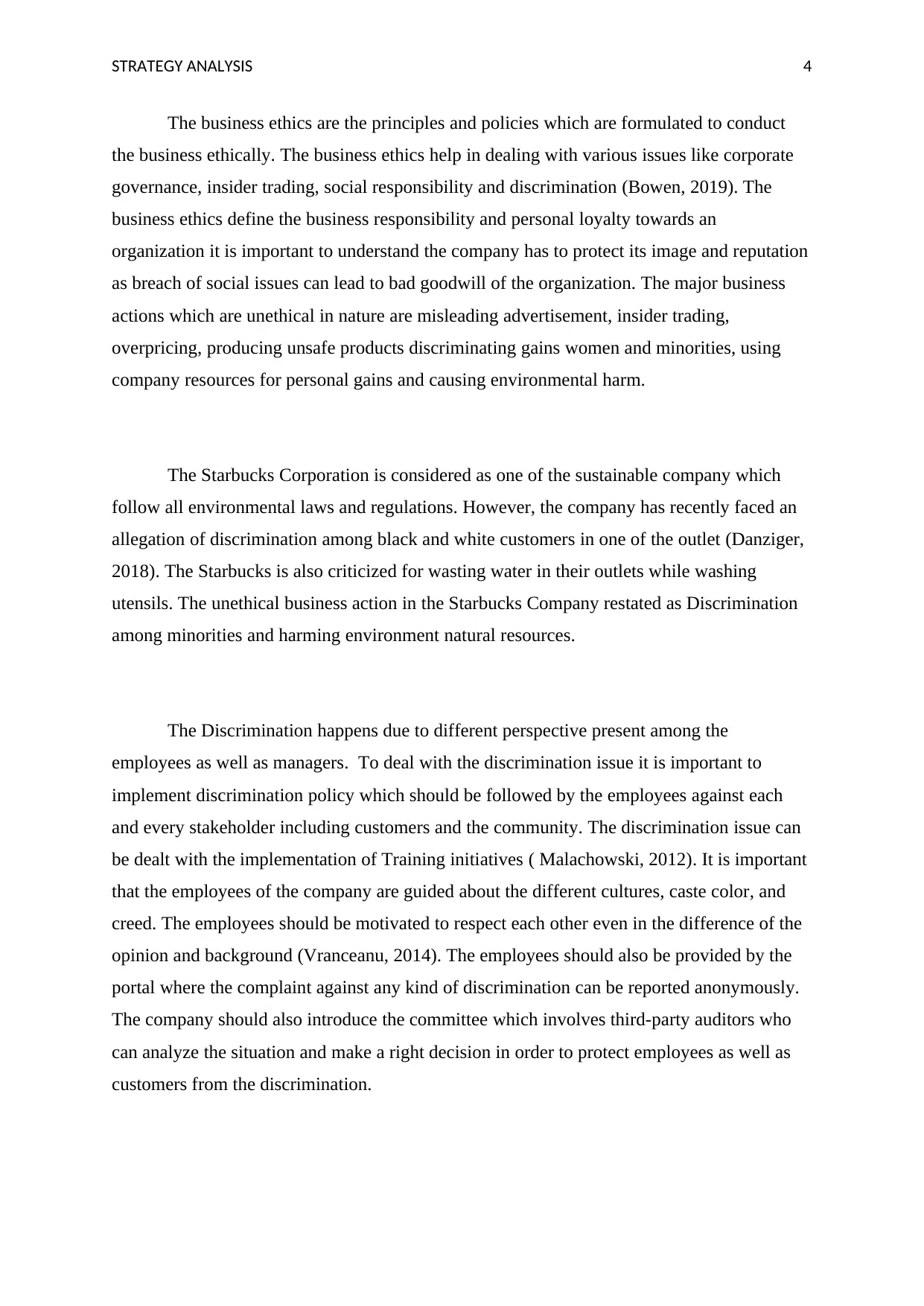
STRATEGY ANALYSIS 4
The business ethics are the principles and policies which are formulated to conduct
the business ethically. The business ethics help in dealing with various issues like corporate
governance, insider trading, social responsibility and discrimination (Bowen, 2019). The
business ethics define the business responsibility and personal loyalty towards an
organization it is important to understand the company has to protect its image and reputation
as breach of social issues can lead to bad goodwill of the organization. The major business
actions which are unethical in nature are misleading advertisement, insider trading,
overpricing, producing unsafe products discriminating gains women and minorities, using
company resources for personal gains and causing environmental harm.
The Starbucks Corporation is considered as one of the sustainable company which
follow all environmental laws and regulations. However, the company has recently faced an
allegation of discrimination among black and white customers in one of the outlet (Danziger,
2018). The Starbucks is also criticized for wasting water in their outlets while washing
utensils. The unethical business action in the Starbucks Company restated as Discrimination
among minorities and harming environment natural resources.
The Discrimination happens due to different perspective present among the
employees as well as managers. To deal with the discrimination issue it is important to
implement discrimination policy which should be followed by the employees against each
and every stakeholder including customers and the community. The discrimination issue can
be dealt with the implementation of Training initiatives ( Malachowski, 2012). It is important
that the employees of the company are guided about the different cultures, caste color, and
creed. The employees should be motivated to respect each other even in the difference of the
opinion and background (Vranceanu, 2014). The employees should also be provided by the
portal where the complaint against any kind of discrimination can be reported anonymously.
The company should also introduce the committee which involves third-party auditors who
can analyze the situation and make a right decision in order to protect employees as well as
customers from the discrimination.
The business ethics are the principles and policies which are formulated to conduct
the business ethically. The business ethics help in dealing with various issues like corporate
governance, insider trading, social responsibility and discrimination (Bowen, 2019). The
business ethics define the business responsibility and personal loyalty towards an
organization it is important to understand the company has to protect its image and reputation
as breach of social issues can lead to bad goodwill of the organization. The major business
actions which are unethical in nature are misleading advertisement, insider trading,
overpricing, producing unsafe products discriminating gains women and minorities, using
company resources for personal gains and causing environmental harm.
The Starbucks Corporation is considered as one of the sustainable company which
follow all environmental laws and regulations. However, the company has recently faced an
allegation of discrimination among black and white customers in one of the outlet (Danziger,
2018). The Starbucks is also criticized for wasting water in their outlets while washing
utensils. The unethical business action in the Starbucks Company restated as Discrimination
among minorities and harming environment natural resources.
The Discrimination happens due to different perspective present among the
employees as well as managers. To deal with the discrimination issue it is important to
implement discrimination policy which should be followed by the employees against each
and every stakeholder including customers and the community. The discrimination issue can
be dealt with the implementation of Training initiatives ( Malachowski, 2012). It is important
that the employees of the company are guided about the different cultures, caste color, and
creed. The employees should be motivated to respect each other even in the difference of the
opinion and background (Vranceanu, 2014). The employees should also be provided by the
portal where the complaint against any kind of discrimination can be reported anonymously.
The company should also introduce the committee which involves third-party auditors who
can analyze the situation and make a right decision in order to protect employees as well as
customers from the discrimination.
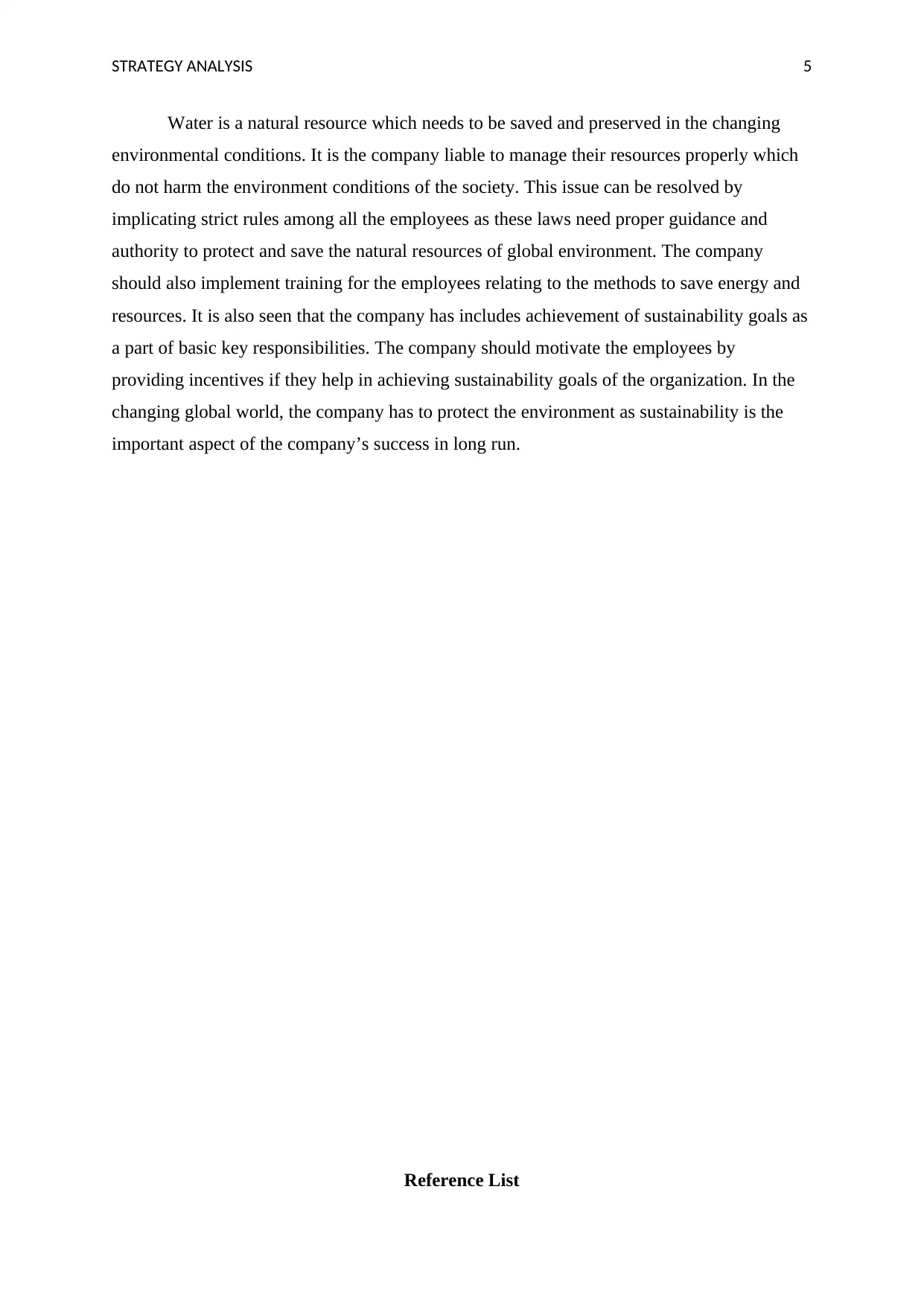
STRATEGY ANALYSIS 5
Water is a natural resource which needs to be saved and preserved in the changing
environmental conditions. It is the company liable to manage their resources properly which
do not harm the environment conditions of the society. This issue can be resolved by
implicating strict rules among all the employees as these laws need proper guidance and
authority to protect and save the natural resources of global environment. The company
should also implement training for the employees relating to the methods to save energy and
resources. It is also seen that the company has includes achievement of sustainability goals as
a part of basic key responsibilities. The company should motivate the employees by
providing incentives if they help in achieving sustainability goals of the organization. In the
changing global world, the company has to protect the environment as sustainability is the
important aspect of the company’s success in long run.
Reference List
Water is a natural resource which needs to be saved and preserved in the changing
environmental conditions. It is the company liable to manage their resources properly which
do not harm the environment conditions of the society. This issue can be resolved by
implicating strict rules among all the employees as these laws need proper guidance and
authority to protect and save the natural resources of global environment. The company
should also implement training for the employees relating to the methods to save energy and
resources. It is also seen that the company has includes achievement of sustainability goals as
a part of basic key responsibilities. The company should motivate the employees by
providing incentives if they help in achieving sustainability goals of the organization. In the
changing global world, the company has to protect the environment as sustainability is the
important aspect of the company’s success in long run.
Reference List
⊘ This is a preview!⊘
Do you want full access?
Subscribe today to unlock all pages.

Trusted by 1+ million students worldwide
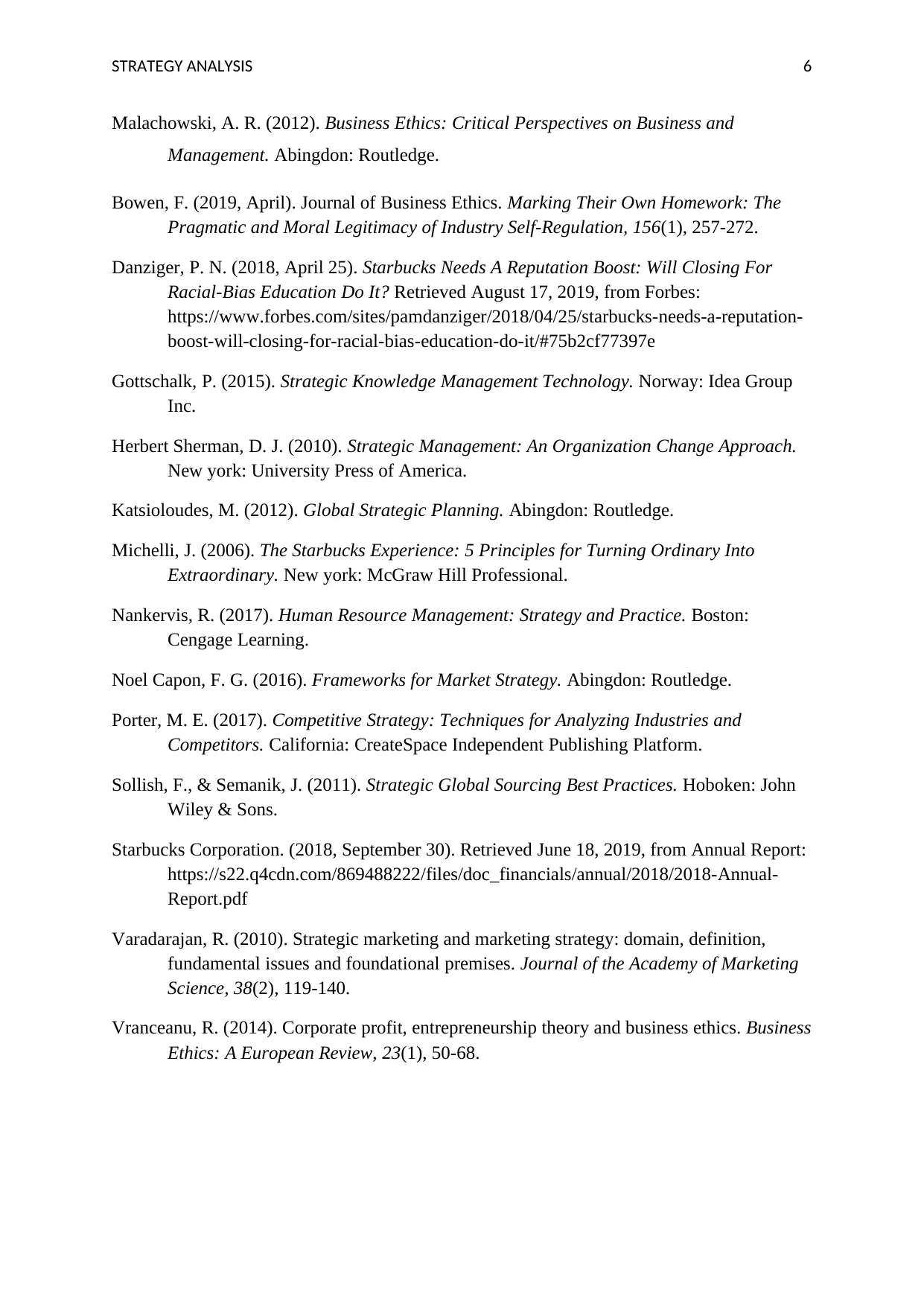
STRATEGY ANALYSIS 6
Malachowski, A. R. (2012). Business Ethics: Critical Perspectives on Business and
Management. Abingdon: Routledge.
Bowen, F. (2019, April). Journal of Business Ethics. Marking Their Own Homework: The
Pragmatic and Moral Legitimacy of Industry Self-Regulation, 156(1), 257-272.
Danziger, P. N. (2018, April 25). Starbucks Needs A Reputation Boost: Will Closing For
Racial-Bias Education Do It? Retrieved August 17, 2019, from Forbes:
https://www.forbes.com/sites/pamdanziger/2018/04/25/starbucks-needs-a-reputation-
boost-will-closing-for-racial-bias-education-do-it/#75b2cf77397e
Gottschalk, P. (2015). Strategic Knowledge Management Technology. Norway: Idea Group
Inc.
Herbert Sherman, D. J. (2010). Strategic Management: An Organization Change Approach.
New york: University Press of America.
Katsioloudes, M. (2012). Global Strategic Planning. Abingdon: Routledge.
Michelli, J. (2006). The Starbucks Experience: 5 Principles for Turning Ordinary Into
Extraordinary. New york: McGraw Hill Professional.
Nankervis, R. (2017). Human Resource Management: Strategy and Practice. Boston:
Cengage Learning.
Noel Capon, F. G. (2016). Frameworks for Market Strategy. Abingdon: Routledge.
Porter, M. E. (2017). Competitive Strategy: Techniques for Analyzing Industries and
Competitors. California: CreateSpace Independent Publishing Platform.
Sollish, F., & Semanik, J. (2011). Strategic Global Sourcing Best Practices. Hoboken: John
Wiley & Sons.
Starbucks Corporation. (2018, September 30). Retrieved June 18, 2019, from Annual Report:
https://s22.q4cdn.com/869488222/files/doc_financials/annual/2018/2018-Annual-
Report.pdf
Varadarajan, R. (2010). Strategic marketing and marketing strategy: domain, definition,
fundamental issues and foundational premises. Journal of the Academy of Marketing
Science, 38(2), 119-140.
Vranceanu, R. (2014). Corporate profit, entrepreneurship theory and business ethics. Business
Ethics: A European Review, 23(1), 50-68.
Malachowski, A. R. (2012). Business Ethics: Critical Perspectives on Business and
Management. Abingdon: Routledge.
Bowen, F. (2019, April). Journal of Business Ethics. Marking Their Own Homework: The
Pragmatic and Moral Legitimacy of Industry Self-Regulation, 156(1), 257-272.
Danziger, P. N. (2018, April 25). Starbucks Needs A Reputation Boost: Will Closing For
Racial-Bias Education Do It? Retrieved August 17, 2019, from Forbes:
https://www.forbes.com/sites/pamdanziger/2018/04/25/starbucks-needs-a-reputation-
boost-will-closing-for-racial-bias-education-do-it/#75b2cf77397e
Gottschalk, P. (2015). Strategic Knowledge Management Technology. Norway: Idea Group
Inc.
Herbert Sherman, D. J. (2010). Strategic Management: An Organization Change Approach.
New york: University Press of America.
Katsioloudes, M. (2012). Global Strategic Planning. Abingdon: Routledge.
Michelli, J. (2006). The Starbucks Experience: 5 Principles for Turning Ordinary Into
Extraordinary. New york: McGraw Hill Professional.
Nankervis, R. (2017). Human Resource Management: Strategy and Practice. Boston:
Cengage Learning.
Noel Capon, F. G. (2016). Frameworks for Market Strategy. Abingdon: Routledge.
Porter, M. E. (2017). Competitive Strategy: Techniques for Analyzing Industries and
Competitors. California: CreateSpace Independent Publishing Platform.
Sollish, F., & Semanik, J. (2011). Strategic Global Sourcing Best Practices. Hoboken: John
Wiley & Sons.
Starbucks Corporation. (2018, September 30). Retrieved June 18, 2019, from Annual Report:
https://s22.q4cdn.com/869488222/files/doc_financials/annual/2018/2018-Annual-
Report.pdf
Varadarajan, R. (2010). Strategic marketing and marketing strategy: domain, definition,
fundamental issues and foundational premises. Journal of the Academy of Marketing
Science, 38(2), 119-140.
Vranceanu, R. (2014). Corporate profit, entrepreneurship theory and business ethics. Business
Ethics: A European Review, 23(1), 50-68.
1 out of 7
Related Documents
Your All-in-One AI-Powered Toolkit for Academic Success.
+13062052269
info@desklib.com
Available 24*7 on WhatsApp / Email
![[object Object]](/_next/static/media/star-bottom.7253800d.svg)
Unlock your academic potential
Copyright © 2020–2025 A2Z Services. All Rights Reserved. Developed and managed by ZUCOL.




